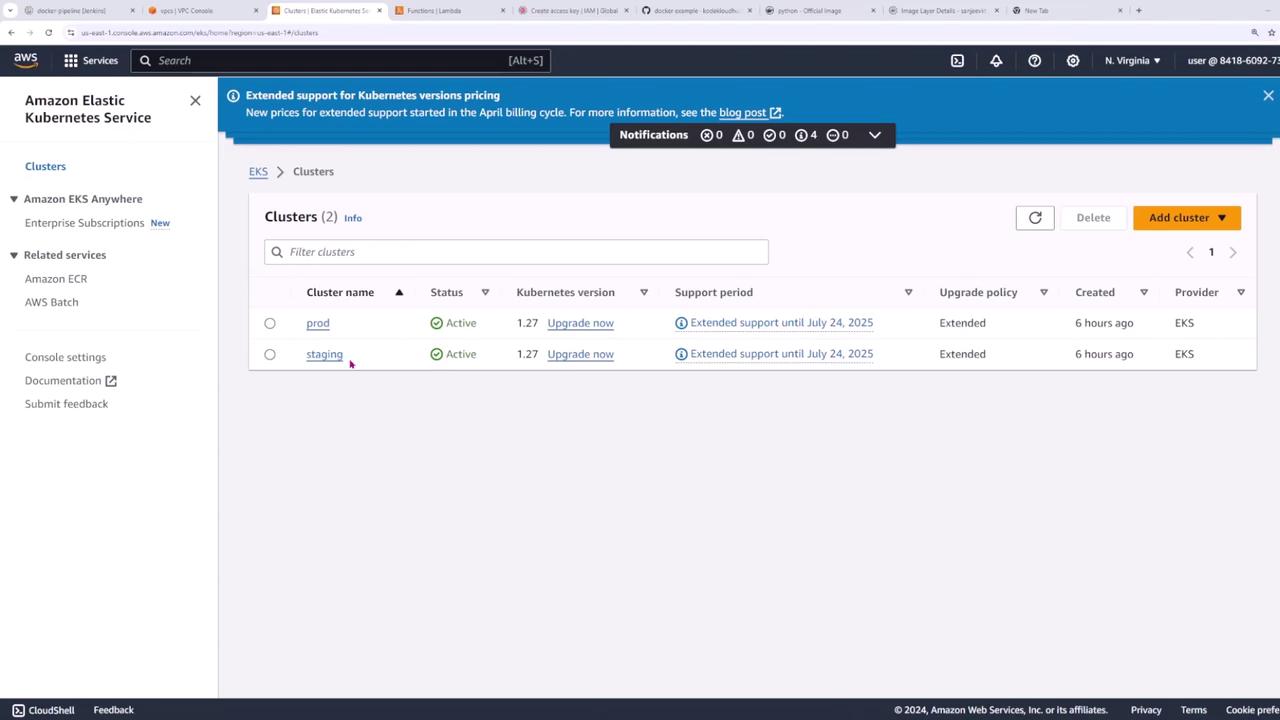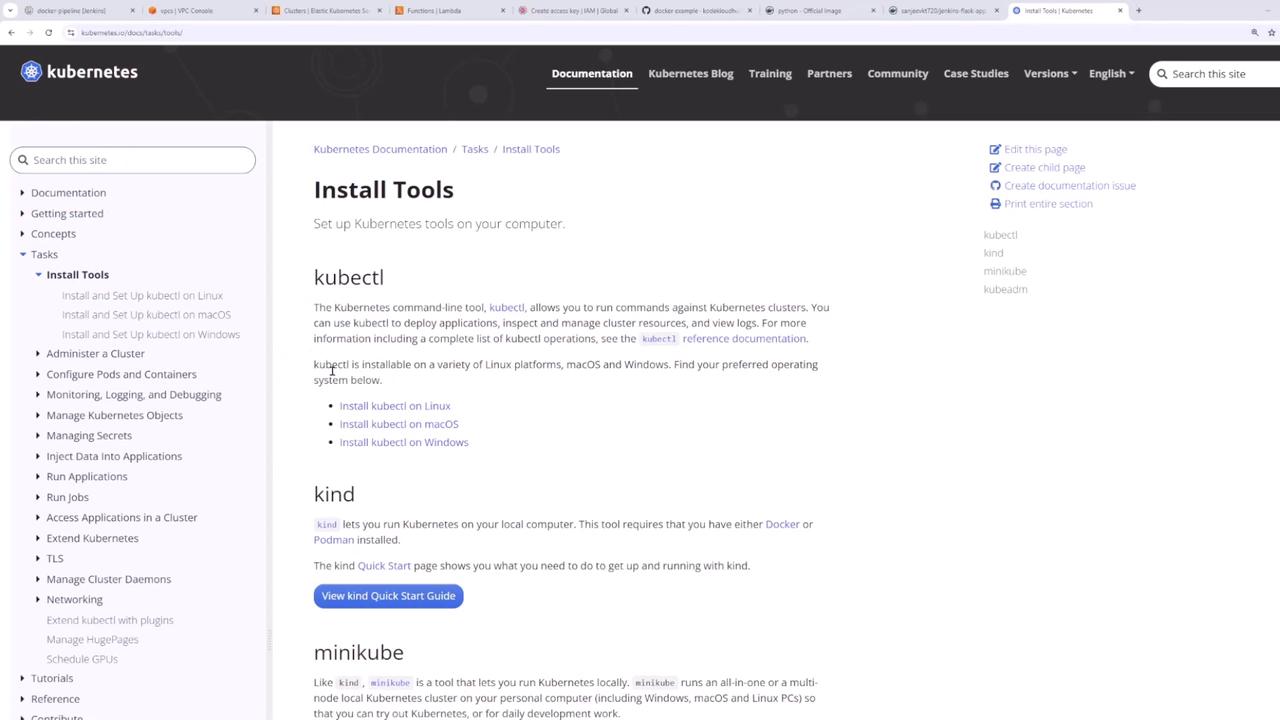Jenkins Project: Building CI/CD Pipeline for Scalable Web Applications
Kubernetes
Demo Working with Kubernetes
In this lesson, you'll learn how to interact with Kubernetes clusters on AWS EKS using the kubectl CLI. We have two clusters set up—one for production and another for staging. Follow along as we inspect the kubeconfig file, switch between clusters, deploy a Flask application, perform load testing with k6, and update the application image.
Accessing the EKS Clusters
Open the AWS EKS console to view your clusters. In our setup, the console shows two active clusters named "prod" and "staging," both running Kubernetes version 1.27 with extended support until July 24, 2025.

To interact with these clusters, you need the kubectl CLI utility. Follow the installation instructions provided in the Kubernetes documentation tailored for your operating system.

Inspecting the kubeconfig File
Your kubeconfig file, usually located at ~/.kube/config, contains configurations for your clusters, users, and contexts. To inspect the file, run:
cat ~/.kube/config > config.yaml
Open config.yaml in your preferred IDE.
Important
Do not commit this file to Git or any public repository as it contains sensitive cluster credentials.
A section from the file for the staging cluster might look like this:
apiVersion: v1
clusters:
cluster:
certificate-authority: C:\Users\sanje\.minikube\ca.crt
extensions:
- extension:
last-update: Sun, 04 Aug 2024 23:53:45 MDT
user:
exec:
apiVersion: client.authentication.k8s.io/v1beta1
args:
- eks
- get-token
- --output
- json
- --cluster-name
- staging
- --region
- us-east-1
command: aws
env:
- name: AWS_STS_REGIONAL_ENDPOINTS
value: regional
interactiveMode: IfAvailable
provideClusterInfo: false
Similarly, the file includes configurations for the production cluster. Notice that the current-context is set to the production cluster by default:
contexts:
- context:
cluster: prod.us-east-1.eksctl.io
user: [email protected]
name: [email protected]
- context:
cluster: staging.us-east-1.eksctl.io
user: [email protected]
name: [email protected]
current-context: [email protected]
kind: Config
preferences: {}
Switching Between Clusters
To operate on different clusters, switch contexts. First, check the nodes on your current production cluster:
kubectl get node
The output might resemble:
NAME STATUS ROLES AGE VERSION
ip-192-168-60-39.ec2.internal Ready <none> 5h33m v1.27.15-eks-1552ad0
ip-192-168-8-155.ec2.internal Ready <none> 5h33m v1.27.15-eks-1552ad0
To switch to the staging cluster, execute:
kubectl config use-context [email protected]
After switching, verify the change:
kubectl get node
The displayed node names will differ, confirming that you are now connected to the staging cluster.
Deploying the Flask Application
Our Kubernetes configurations are stored in the k8s/ directory, which includes the deployment.yaml and service.yaml files.
Deployment Configuration
The deployment.yaml file sets up a deployment for a Flask application with three replicas:
apiVersion: apps/v1
kind: Deployment
metadata:
name: flask-app
spec:
replicas: 3
selector:
matchLabels:
app: flask-app
template:
metadata:
labels:
app: flask-app
spec:
containers:
- name: flask-app
image: sanjeevkt720/jenkins-flask-app:v3
resources:
limits:
memory: "128Mi"
cpu: "500m"
ports:
- containerPort: 5000
Service Configuration
The service.yaml file defines a LoadBalancer service to expose the Flask application externally:
apiVersion: v1
kind: Service
metadata:
name: flask-app-service
spec:
type: LoadBalancer
selector:
app: flask-app
ports:
- port: 5000
targetPort: 5000
This configuration assigns an external IP and possibly a DNS name that routes incoming traffic to the correct pods.
Deploying Resources to the Cluster
Before deploying, confirm that your current context is correct:
kubectl config current-context
Deploy all resources (both deployment and service) with:
kubectl apply -f k8s/
You should see output similar to:
deployment.apps/flask-app created
service/flask-app-service created
Next, verify that the deployment and pods are running:
kubectl get deployment
Example output:
NAME READY UP-TO-DATE AVAILABLE AGE
flask-app 3/3 3 3 177m
And check the pods:
kubectl get pod
Example output:
NAME READY STATUS RESTARTS AGE
flask-app-795b844d7f-24pfw 1/1 Running 0 177m
flask-app-795b844d7f-7cdp 1/1 Running 0 177m
flask-app-795b844d7f-lmclx 1/1 Running 0 177m
Finally, retrieve the service details to access your application:
kubectl get svc
Example output:
NAME TYPE CLUSTER-IP EXTERNAL-IP PORT(S)
flask-app-service LoadBalancer 10.100.67.6 a2718e7dae7964585baeb017221aeb6d-1943673624.us-east-1.elb.amazonaws.com 5000/TCP
kubernetes ClusterIP 10.100.0.1 <none> 443/TCP
Copy the EXTERNAL-IP or hostname and access your application on port 5000.
Load Testing with k6
Use k6 to simulate user traffic and measure your application's performance. k6 lets you define virtual users (VUs), duration, and thresholds for request response times.
Create a file named acceptance-test.js with the following content:
import http from "k6/http";
import { sleep } from "k6";
export const options = {
vus: 10,
duration: "10s",
thresholds: {
http_req_duration: ["p(90)<600"], // 90% of requests must complete in under 600ms
},
};
export default function () {
http.get(`http://${__ENV.SERVICE}`);
sleep(1);
}
The target URL is provided via an environment variable. Retrieve the external hostname and port of your service with a command similar to:
kubectl get svc flask-app-service -o jsonpath='{.status.loadBalancer.ingress[0].hostname}:{.spec.ports[0].port}'
Then run the k6 test by setting the SERVICE environment variable:
k6 run -e SERVICE=<external-hostname>:5000 acceptance-test.js
During the test, k6 will simulate 10 virtual users over 10 seconds, ensuring that 90% of the requests complete in under 600 milliseconds. After the test, you'll see statistical data including average, median, and maximum response times.
Updating the Application Version
Our current deployment uses version 3 of the image:
spec:
template:
metadata:
labels:
app: flask-app
spec:
containers:
- name: flask-app
image: sanjeevkt720/jenkins-flask-app:v3
resources:
limits:
memory: "128Mi"
cpu: "500m"
ports:
- containerPort: 5000
To update the application to a new version (for example, v5), follow these steps:
Build the New Image
docker build -t sanjeevkt720/jenkins-flask-app:v5 .Push the Image to Docker Hub
docker push sanjeevkt720/jenkins-flask-app:v5Update the Deployment in Kubernetes
Use the
kubectl set imagecommand to update the image version:kubectl set image deployment/flask-app flask-app=sanjeevkt720/jenkins-flask-app:v5You should see a confirmation:
deployment.apps/flask-app image updated
Finally, verify the rollout status of your deployment and refresh your application to ensure it is now using version 5.
Summary
This lesson covered managing multiple Kubernetes clusters, deploying a Flask application, conducting load tests with k6, and updating the application version seamlessly—all crucial skills for maintaining an efficient CI/CD pipeline.
Watch Video
Watch video content